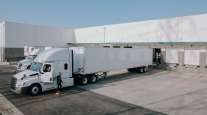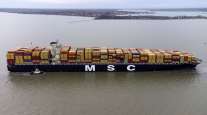Bloomberg News
Big Ships Snag Unusual Loads as Dry Bulk Market Tightens

[Stay on top of transportation news: Get TTNews in your inbox.]
Shipments of timber and grain are being loaded onto a class of ship normally reserved for other cargo as strong demand to move commodities causes dislocations to the supply of vessels.
Logs from Uruguay and grain from Brazil are set to be loaded on giant capesize ships this month or next, according to shipping data from S&P Global Platts. The vessels normally are used to transport coal and iron ore — the industry’s two main cargoes. By contrast, timber typically is moved on smaller vessels, according to Genco Shipping & Trading Ltd. CEO John Wobensmith.
“It just shows you how tight the overall dry-bulk market is, and it’s only going to get tighter,” Wobensmith said March 18.
“[Elevated freight rates are] not something that is for the next three months,” he said. “This has got legs going well in to 2022 because of the low supply situation.”

Even before the pandemic, DHL's Larry S. Onge and Jim Monkmeyer set up strategies and implemented technology in order to respond to disruptions. Now, they know exactly how to get the vaccine from point A to point B — and, better, how to do it at a global scale. Hear a snippet, above, and get the full program by going to RoadSigns.TTNews.com.
Capesize rates averaged about $18,000 a day so far this year, a jump of almost 40% from last year’s average, Wobensmith said. They are poised to rise further, helped by strong coal import volumes in India and Vietnam, and rising grain and iron ore exports from Brazil, he said.
New York-listed Genco owns 41 vessels, according to its website. The firm’s shares have more than doubled in the past year.
Capesizes are normally used for iron ore and coal, cargoes that will represent about 2.7 billion tons of seaborne trade this year — by far the biggest source of demand for non-oil commodity freighters, data from Clarkson Research Services Ltd. show.
In normal times, more niche cargoes such as logs tend to be delivered on smaller vessels like Panamaxes, the largest to navigate the Panama Canal. But costs for those carriers have surged to the point where they are more expensive than capesizes.
New orders for bulk ships make up 6.8% of the total fleet’s deadweight tonnage, near the lowest in data extending to 2005, according to IHS Markit data on Bloomberg. There’s reluctance to buy new ships because of changing environmental regulations and uncertainty over what will emerge as the dominant clean fuel, said Wobensmith. Genco believes ammonia will be used by the industry in the future, he added.
The supply of dry-bulk ships already was under pressure as COVID-19 restrictions on seafarers and port workers slowed cargo deliveries, according to Gerry Craggs, managing director at Stemcor S.E.A. Pte Ltd. Government stimulus to pump up COVID-19-ravaged economies also is boosting demand for raw materials, he said.
“We’re in the phase of fiscal stimuli virtually everywhere in the world,” Craggs said March 19. “It’s driving up demand for virtually everything, and we’re seeing that effect in the steel sector and in commodities sectors.”
Dry bulk has started 2021 on a “high note,” Bloomberg Intelligence analyst Lee Klaskow said in a report last week. “China and an expected global economic recovery have set up one the strongest opening quarters for dry-bulk demand in a decade.”
Want more news? Listen to today's daily briefing below or go here for more info:




